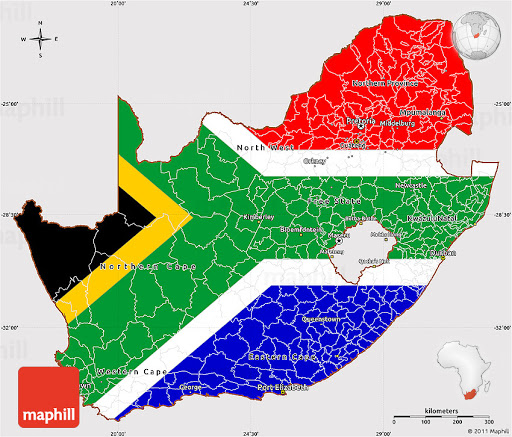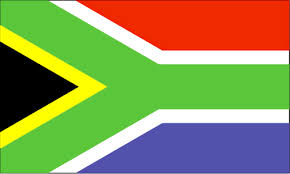
South Africa.
.
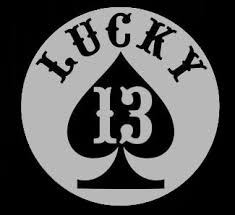
Trackchasing Country #13
Greetings from places on the way to and from the faraway and intriguing country of South Africa. Click on the links below to read about the “story” and see the photos and videos from this trip to the southern tip of the African continent. How many people have been to South Africa, home to my trackchasing country #13?
PART 1 – TOURING
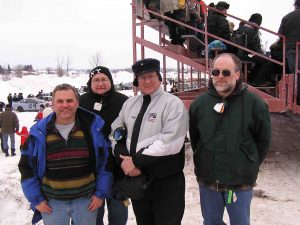
Editor’s note: On Valentine’s Day 2008 Carol and I headed out for a three-day trackchasing trip to Connecticut, Maine and Ontario, Canada. That was a fun trip that featured both ice racing and indoor racing. We met up with other trackchasers. Can you tell which of the above is NOT a Dreaded East Coast Trackchaser? I know….this isn’t easy! Carol and I then ventured over to New York City. From there Carol would head back out west while I would try my luck with Africa. Don’t worry. That’s how we do things.
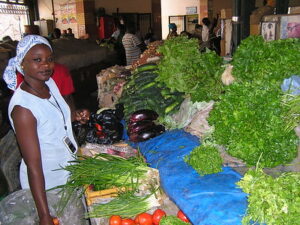
This is the Kermel Market in downtown Dakar. It’s famous for fruits and vegetbles. Many tourist sites also warned that this could be a dangerous place for tourists.
Greetings from Dakar, Senegal, Johannesburg, South Africa and surrounding areas.
We’ve spent the last several nights in Africa since leaving New York City. I woke up in Dakar, Senegal this morning. We went to sleep in South Africa. This is what transpired over the first half of our African continent trackchasing adventure.
TO WHAT ENDS OF THE EARTH WILL I GO TRACKCHASING TOUR?
TODAY’S HEADLINES
What’s the REAL purpose in traveling to some faraway foreign country in pursuit of a new track?……………….more in “The Purpose”.

This trip required some $600 worth of inoculations …………..details in “Before the trip”.
I’ve been too many places, but none with a more ominous reputation for danger than Dakar, Senegal on the continent of Africa. …………..details in “Wednesday, February 20, 2008”.
I have always wanted to do a full-on African safari. I finally got my wish …………..details in “Friday, February 22, 2008”.
The Purpose
One of my primary trackchasing objectives this year is to see new tracks in foreign countries. This trip’s new track was planned to be in a very far away place, South Africa. The journey would require more than 20,000 miles of round-trip air travel. When I go trackchasing in a foreign country, my main purpose is to see the country and experience its culture and people. The race I will see is what motivates me to visit the country. However, the race is far down the list in the overall importance of the things I want to experience and do for my personal enjoyment.
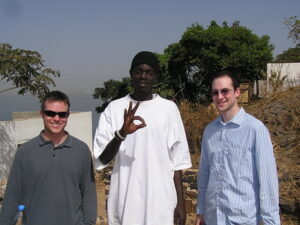
This is Mohamed. He was our guide for the day. He was 22 years old and gave us all the details we could ever want to know about his island.
I would be accompanied on this trip by my son, J.J. and his friend (and now mine) Will Van Horne. We were a great threesome. We all love adventures like this one. Although you couldn’t come along for this particular trip, I want you to have just about as much fun seeing and “doing” South Africa as we did. So sit down, strap on your seatbelt and imagine yourselves traipsing around the continent of Africa as we did for a week. I hope you enjoy the ride and suspect it might be a bit safer but maybe not quite as exciting as actually being there.
Before the trip
Trackchasing in a foreign country takes a good deal more planning and expense that simply schlepping over to another little bullring in the states. Trackchasing in South Africa required additional preparation beyond anything I have ever done before I visited my other 12 trackchasing countries.
I’m talking about shots! I ended up getting vaccines for Yellow Fever, Hepatitis A and Hepatitis B. I also got a tetanus shot. This was followed up by a six-week course (one pill per week) for Malaria.

With the Malaria pills, I had a choice between taking one pill per day for six weeks or one pill per week for six weeks. Obviously, the latter choice seemed preferable. This choice had one minor side effect. The doctor told me a small percentage of people have severe nightmares! Of course, in the pursuit of trackchasing, what are a few bad dreams.
My Yellow Fever vaccination was difficult to get. Most Yellow Fever vaccination medicines come in five-unit dosages. This means that a vile of the vaccine can inoculate five people. However, once the vile is opened all of the vaccines must be used within one hour. That meant that I had to schedule an appointment when four others were going to get their Yellow Fever shots. I am happy to report that my health insurance covered most of the more than $600 expense for these medicines.
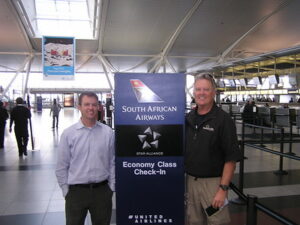
Our flight to Dakar would be nearly nine hours long. Yep! J.J. and I were flying in coach.
Tuesday, February 19, 2008
Earlier today, I watched Carol board a flight from New York to San Francisco and then she was off to Los Angeles. Just a couple of hours later J.J. and Will joined me at New York’s JFK airport. At around 5 p.m. we left for Senegal one of 47 African countries on the “dark” continent. It took us about nine hours to reach our destination. Senegal is five hours ahead of the Eastern Time zone. We arrived at 5:30 a.m. local time on Wednesday morning.
J.J. established the itinerary for the first to days of our trip to Africa. He came up with the idea of stopping in the African country of Senegal. All of the online reviews of Senegal told of mainly one thing. It was potentially a very dangerous place to visit!
Wednesday, February 20, 2008
We had been warned that getting a cab outside of the Dakar, Senegal airport could be an adventure. When we landed in Dakar in the early morning, it was dark. We cleared customs with ease. The next step was to walk outside in the dark with a large crowd of people wanting to give us transportation to wherever we were going. Some 94% of the people in Africa are black. Senegal was no exception.
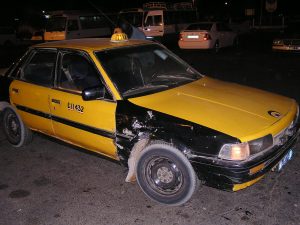
Early morning Dakar, Senegal
We walked past several people offering to give us rides. Finally, we randomly picked a cab. I have ridden in some pretty worn out and beat up taxis in my time. Typically, Mexico had been the worst. However, nothing could beat the condition of Dakar taxis. The cabs were beaten up, the headliners were drooping and the headlights barely worked. We negotiated a price to take us to our downtown hotel.
I will forever remember our drive in the dark. It was one of the most ominous adventures I have ever taken. It was warm. The temperature was about 75 degrees. The roads changed from dirt to asphalt and back again as we traveled toward downtown Dakar. The potholes looked like canyons. The air carried the dust from the roads and the ashes from fires being burned at the area’s residences.
Our taxi driver had his bright lights on. They illuminated the roadway as if he were using a flashlight. Shadowing figures of pedestrians darted out of the darkness to cross the road in front of us. This was Tuesday. It was a workday. Worn out buses built to accommodate 15 people were carrying 20-25 people. We rarely exceeded 30 M.P.H.
Within a short distance of the airport, the driver pulled over to a hotel and stopped. He told us we had reached our hotel. We were at the Ocean Hotel. We were supposed to be at the Hotel L’Oceanic. The driver informed us our destination would be a longer distance and a greater but unidentified fare. I knew this would create some conflict in the very near future.
We continued on our drive. If someone had been measuring our blood pressure or the wideness of our eyes, they would have been shocked. This was an eerie experience. Since we were in the dark, it was impossible to capture what we had just seen on video or with my digital camera. J.J., Will and I will remember it forever, however.
Finally, we arrived at our hotel. J.J. had made the reservation. Beginning airline pilots do not make much money. They are thrifty. I do not suspect many, if any, of my readers had ever stayed in a place like this. It was old. It was located a few blocks from downtown, a little off the beaten path. It was now 7 a.m. The sun was just beginning to come up. We didn’t think our room for the day would be ready, but we had no place else to go.
When we entered the lobby, we noticed it was small. It might have been six feet by eight feet. The hotel clerk helped us negotiate with our taxi driver in African or maybe French. We didn’t understand much, but I could tell the taxi driver was not happy. After a while the driver went away with less money than he had been demanding. I was glad to see him go.

After an overnight flight we landed in Senegal at 6 a.m. It was time for breakfast which consisted of French bread, juice and tea.
Our room was not ready. Nevertheless, we didn’t feel safe walking outside the hotel in the early dawn. We decided to have breakfast in a small hotel restaurant. Breakfast consisted of juice and French bread.
Dakar is eight hours ahead of California’s Pacific Time zone. It was 7 a.m. in Dakar and 11 p.m. in San Clemente. For me, it was time to go to bed. However, for the three of us, our day was just beginning in Dakar. The objective would be to stay up until 8 p.m. or so, local time. Then we could crash and get 8-10 hours of sleep. We would nearly be on local time after that.
Our hotel was within one block of the Fernel market. This was a large food and vegetable market. It had been reported that this was one of the most dangerous spots for tourists in all of Dakar. This was our first tourist stop of the trip. We were more than apprehensive. I didn’t know if carrying my heavy laptop bag with me made my computer more or less safe than leaving it back at the hotel, but I carried it everywhere I went since I didn’t want to leave it with the hotel and we didn’t have a rental car.
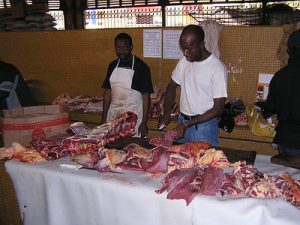
We were here in the morning as the butchers were getting their meats ready for sale.
We were the only white people I saw in the market for the entire time we were there. For the most part, we were ignored. However, every time I took a flash picture it was as if a neon sign flashed, “look at these three white guys invading your culture. Do you want to make them pay?” Nevertheless, I felt a responsibility to the readers of the Trackchaser Report and viewers at www.randylewis.org. to keep taking photos. I guess it was the same mentality that motivates a photojournalist during wartime.
Following our tour of the market was our main tourist stop for the day. We would be visiting Goree Island. Goree Island marks the westernmost spot in all of Africa. Goree Island is also infamous for housing the lion’s share of the slave trade for more than 100 years up until 1848.
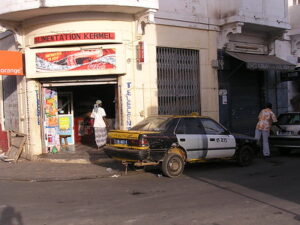
Downtown Dakar, Senegal.
To get to the island, we would have to walk about one mile, then board a ferry for a 20-minute ride. Our walk toward the water took us past all kinds of street vendors who were selling their wares on a Tuesday morning. We tried to stay on the main streets but it was difficult.
We came across a young couple just leaving their house. I asked them the way to the boat dock. They were light-skinned people of Lebanese descent who were natives of Senegal. They were happy to direct us. They confirmed that we were in a more than dangerous area. They offered to drive us to the boat docks in their car.
We were eager to accept their help. After we had entered their car, it dawned on me that we had done exactly what the tour books advise against. They say, “Don’t ever get in a car with anyone you don’t know. People will try to convince you they are your friends, to gain your confidence and then do you harm”. I guess as a former corporate recruiter, I count on my ability to size up human beings quickly. The couple delivered us safely and quickly to our destination.
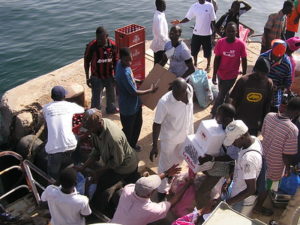
Supplies are off loaded for the 1,200 residents of Goree Island.
We were about 30 minutes early for our trip to Goree Island. As we waited in the main lobby, we were joined by school kids taking a field trip, as well as other tourists, bound for a day on the island. It was busy on the ferry over to the island.
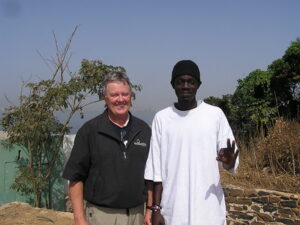
I’m 6’3″ Mohamed was two or three inches taller than me.
Once we arrived, we were inundated with young men wanting to be our guides for the day. Our plan was to go without a guide and see the island on our own terms. However, a young man some six feet five inches tall named “Mohamed” changed our minds. He was a fast talker and assured us that if we didn’t like his service, we would not have to pay him. Mohamed actually made our day. We were happy with our choice.
Mohamed spoke English well enough for us to understand him. He told us of the history of slavery on the island. He told us “blacks were selling blacks” in the slave trade. Mohamed reminded us that families were split up. The father might be sold to one country, the mother to another and the children to yet another country. Young virgin girls were the most valuable of all.
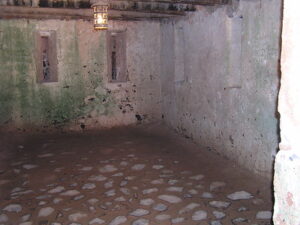
Mohamed told us that upwards of 50 people would be placed in these cells for days on end.
During our walk over the island that covered more than two miles and more than three hours, we saw the stone cells where future slaves were held before the auction. People who weren’t big enough or strong enough were fed large portions of food and beans to “ready them for the market”.
There are 1,200 people who live permanently on Goree Island. According to Mohamed, 400 of those folks are Christians and 800 are Muslims. Mohamed was a Muslim.
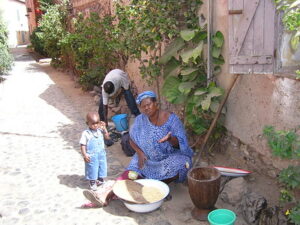
This woman was sorting grains in the shade of a very warm day.
There was a good deal of African art and handcrafts being sold all over the island. I bought two beautiful African necklaces as gifts. We also were delivered to an underground bunker where a most unusual artisan was making sand paintings. We all agreed that if it were easier to bring these paintings home, we would definitely have bought some.
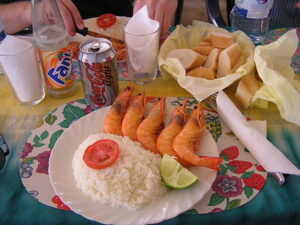
We each had the shrimp and rice lunch. It was delicious with French bread
Toward the end of the day, after we had heard the entire history of Goree Island and walked the entire grounds, it was time for lunch. Mohamed delivered us to his favorite place. There we had shrimp that would give Pascal’s Manale in New Orleans a run for their money. We invited Mohamed to join us for lunch. It was fun to quiz him about his interests. He was a big Michael Jordan fan but told us he had never watched any auto racing.
We rode the ferry back to Dakar in the late afternoon. Goree Island was definitely the highlight of our trip to Senegal. As darkness approached, we assessed our options. We had to leave by 5 a.m. tomorrow morning. We didn’t think we could effectively communicate with the front desk for something as simple as a restaurant recommendation. We definitely didn’t want to be roaming the streets of Dakar after dark. These limitations defined our choice. We would have an early dinner and try to get to bed by 8 p.m. or so. This would be our first night of sleep in a hotel in Africa after spending last night on the plane.
We showed up (as the only patrons) for dinner at 5:30 p.m. The bartender informed us they didn’t start serving food until 7 p.m. That wasn’t good. The South African airline crew had given us a bottle of Champaign. We could drink that until dinner time and we did.
Although our dinner was very good, the service was excruciatingly slow. We didn’t get out of there until 10 p.m. and that included passing up the dessert course that was part of the meal. That slow service had eaten into our sleep time.
Thursday, February 21, 2008
We left Dakar at 5 a.m. while it was still dark out. The taxi driver had climbed the 41 stairs to our second-floor room to tell us he was ready to go. So were we. As we walked down the steps to the hotel lobby area, we found two people sleeping on cots in the darkness of the small lobby space. I’ve never seen anything like that before.
I think we were glad we had come to the country of Senegal to see what we could see. I think we were just as glad to be leaving the country after being here just 24 hours. All three of us would probably tell you that we were a little leery, alright scared if you really want to know the truth during our entire time here.
The cab ride back to the airport was not quite as intimidating as it was yesterday morning. Maybe we were getting used to the scene. The ride was still in the dark. The roads were still torn up and filled with potholes. The air still carried a heavy dose of dust and ash from wood-burning fires. Shadowy figures still darted across the road just feet in front of our approaching cab. The cab’s headlights still couldn’t illuminate the hand in front of your face.
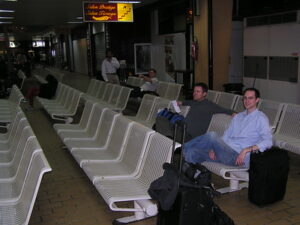
We arrived at the Dakar airport in the dark and we left in the dark for our brief 24-hour stay.
Once we arrived at the airport, we checked in for our flight from Dakar to Johannesburg, South Africa. What was surprising to me was that we would be flying from one African country to another and it was going to take NINE hours. Africa is one large continent. Dakar is closer to New York City than it is to Johannesburg!
When we landed in Johannesburg, clearing customs was easy. South Africa requires a “Yellow Fever Certificate” when a traveler is coming from a country that has Yellow Fever disease, like Senegal. Had we come directly to South Africa from the United States, we would not have been required to get the Yellow Fever inoculation. Although we had our Yellow Fever documentation at the ready, they didn’t ask to see it.
I had reserved a car with the Thrifty Rental Car Company. When I went to get it, I was told we were being upgraded. Dang, I hate it when that happens! We would be getting a Mercedes Compressor four-door sedan. South Africans drive right side steer cars and drive on the left side of the road. Yep! It all adds to the fun.
The overall logistics of this trip would end up being very easy. I did the driving. I had two commercial airline pilots for navigators. We couldn’t go wrong and didn’t very often. We found our hotel with ease.
We were somewhat surprised to see that the Don Eastgate Suites Hotel was situated behind tall wrought iron security gates with a security guard stationed at the entrance. We would come to learn that every hotel that we visited had a similar security arrangement. Every restaurant we visited had its own security staff in very visible positions.
I didn’t notice it until the plane ride home but this is what the British Foreign Office had to say about South Africa:
“There is a high level of crime, but most occurs in townships…..away from the normal tourist destinations…..the standard of driving is variable and there are many fatal accidents”.
I’m glad I didn’t see that until we were on our way home!
I spoke with several white South African natives. They all spoke of a common theme. South Africa has changed and not for the better. Crime is rampant. Security guards are required to be nearly everywhere.
We had some difficulty communicating with the hotel staff when we asked for restaurant recommendations. We were both speaking English, but neither of us seemed to be able to understand the other. However, we were saved at the Don Eastgate Hotel, when a local businessman who was in the hotel holding a staff meeting overheard our conversation. Just at the right moment, Robbie Taitz stepped in. He was obviously knowledgeable about the local scene and asked us what type of food we were looking for.
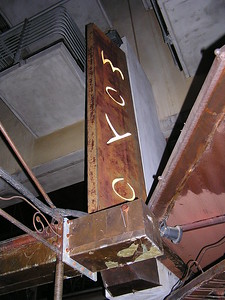
We all looked at each other and said in unison, “African”. A smile came across Robbie’s face. He had just the place for us, Moyo’s. Robbie took some 30 minutes with us to first track down a phone number for the restaurant so the hotel staff could make a booking (reservation) for us. This, along with some other things you might take for granted where you live, was not an easy task. Then Robbie gave us some great directions to the place. We were indebted to him for the time he took with us and the quality of his advice.
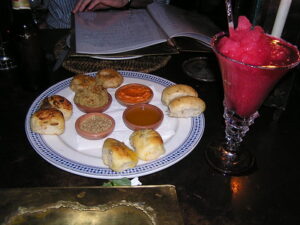
Following a nine hour flight from Dakar to Johannesburg (Joburg) we arrived just in time for dinner. This is Moyo’s one of the trip’s highlights.
Moyo’s at Melrose Arch (+27 (0) 11 684 1477) earns a RANLAY Racing Money Back Guarantee. This place was absolutely fantastic. You might recall my raving about a Mexican restaurant we ate at in Guadalajara, Mexico a few months ago during a trackchasing trip down there. That restaurant was an all-time world top 10 and Moyo’s matched it.
The place was located in a very upscale yuppie type shopping arcade. We were fortunate to get an outdoor table on a night where the temperature was a comfortable 75 degrees.
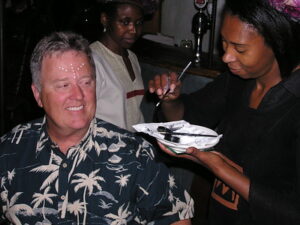
Who knew that my trackchasing hobby would ever take me to such places.
Our servers were all native Africans. After a round of drinks, we were served a complimentary platter of tiny slices of bread and four intriguing dipping sauces. Our starter consisted of sautéed calamari. For my soup and salad course, I selected a peanut and shrimp soup. Fantastic. My entrée was a filet mignon cooked to perfection along with mashed potatoes and vegetables served in the most unique fashion on a metal skillet.
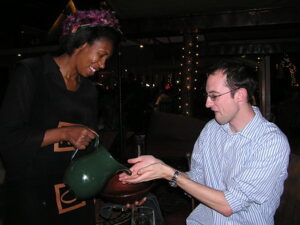
The service here was fantastic. This server brings warm water to our table to wash our hands.
During our meal, we experienced small things I had never seen in all of my culinary past. First, a woman came up to our table and poured warm water over our hands to cleanse them. It wasn’t long before another woman came along to take a digital picture of the three of us as a remembrance of our evening. Finally, toward the end of our meal, still, a third woman came up and asked us if she could give us a face painting. Sure, why not!
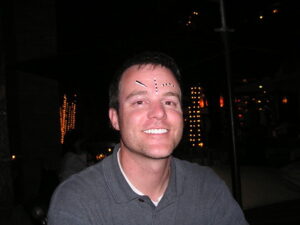
Done!
Our dining experience lasted a couple of hours. We didn’t want it to end. You might imagine such an upscale dining adventure would cost an arm and a leg. We had consumed two rounds of drinks, the calamari appetizer, starters for everyone and full-on entrees for everyone. We capped our meal off with dessert. We had all of the extra attention from the three women who came by the table to wash our hands, take our picture and paint our faces. We had all of this for just under thirty dollars per person. In the states, this level of quality would have cost two or three times as much and I don’t think the service and uniqueness of the evening could have been matched at very many places. As I said, please take a look at the pictures. You won’t want to miss the South African humor that adorned the door of the men’s toilet (restroom).
Following dinner, we were back to our hotel. I had reserved this place in advance over the internet. Our room was essentially a two-room apartment. The living room was huge, the boys had their own room and I had mine. The entire complex overlooked a large lake. The only drawback was that my “world” electrical adapter did not match to the circular holes arranged in the form of a triangle that makes up Africa’s electrical outlet system. I was able to get some “juice” from the special shaver connection in my bathroom.
Friday, February 22, 2008
I was excited about today. We were going on the first day of a two-day African safari. I’ve been trying (not too hard) to get Carol to go on one of these for years. She is fearful of catching some dreadful disease. I was glad to be able to experiment with this “safari sampler” so that someday Carol and I can come back for a longer more deluxe version.
From our Johannesburg location, it was going to be a 6-7 hour drive down to the Hluhluwe-Umfolozi Park. I had made a booking over the internet with a safari specialist travel agent in advance. We would be staying in a “Safari tent”. I had never been to Africa or never taken a safari. I started planning this at the very last minute. I didn’t feel that comfortable with the overall plan.
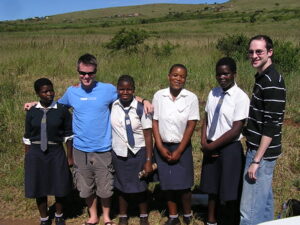
On the way to the park we encountered these school girls. We enjoyed having our picture taken with them.
We had picked up a few bits and pieces of information about park admission and closing times. The drive took longer than we expected. Maybe that’s because we stopped to introduce ourselves to the locals! Once we entered the park’s gate, it was going to be a 45-minute drive to “Mlani Park”, where we would stay the night.
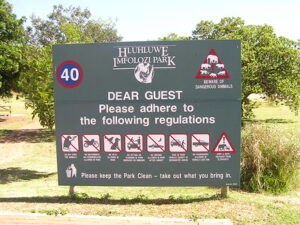
The park had a lot of rules.
We were low on gas. We didn’t have any food. The gas station and the food store closed at 4:30 p.m. There was no driving allowed in the park after dark. If we didn’t get there in time, we would be in the middle of a 3,000 square mile park with no gasoline and no food until morning. Our last meal had come several hours ago and we were starting to get hungry.
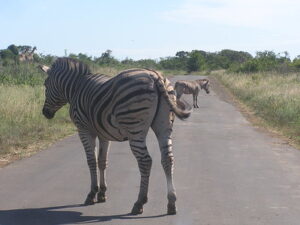
We weren’t 100 yards into the park when we encountered these zebra roaming about.
From the moment we entered the park we began to see wild animals. Just a few yards from the entrance, several zebras stood on the asphalt roadway blocking our path. Then we saw a few giraffes. We joked that the park staff had tethered these animals at the park’s entrance so visitors would be satisfied from the beginning.
The road to our camp was winding and we couldn’t drive very fast. We had to be there by 4:30 p.m. We made it EXACTLY at the closing time. I had to talk fast to get them to keep the one gas pump open while the boys ran to the food store. The best they could score there were cans of Vienna sausages, beef jerky and some cheese. When I joined them, I added some Heineken beer to our stash.
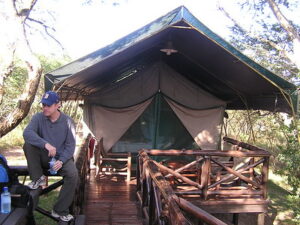
I can’t wait to get Carol out for an African safari.
At check-in, we were given safari camp #22. This was a very nice setup. There were two very large tents. Each had two twin beds, a complete bathroom and shower. Over the beds were large mosquito nets. We had been told that the generator that supplied electrical power would be turned off at 10 p.m. It would not come back on until 8 a.m. the next morning.
Our first mission at camp was to spray ourselves down with Mosquito spray acquired at the camp store. Neither Will nor J.J. had elected to get Malaria pills. Our camp had a full kitchen. We had a stove, refrigerator and sink. The camp also provided our outdoor BBQ grill.

Unfortunately, we had not come very well prepared. We had Vienna sausages, a large chunk of cheese and six cans of Heineken. We had no plates or tableware. I scrounged up two plastic forks and a plastic spoon to aid the process. We ate like bachelors. Had Carol been here, we would have eaten like kings. She would have told us we could have found plates and silverware in our kitchen cabinets as well!
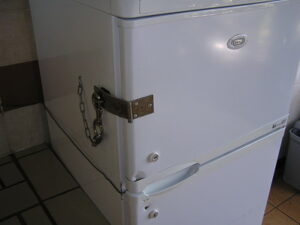
Check out the latches and locks designed to prevent animals from getting a camper’s food.
We had been instructed to make sure all of our food was locked up when we left the camp. Anything that didn’t go in the fridge would go in the secured trash can. Our refrigerator had huge hinge-type locks on it to prevent animals from getting in. We stowed our stuff. We had to get going for a 6 p.m. nighttime game drive.
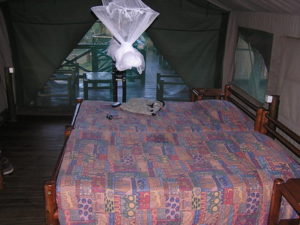
My bedroom for the night with monkeys and lions just outside
The meeting place for our game drive was only a few hundred yards from our campsite. We had been told to make sure we DROVE to the game drive starting point rather than walking from our campsite. We were also instructed never to get further from our tent than any point where we could not see the tent’s interior lights. This all sounded very ominous.
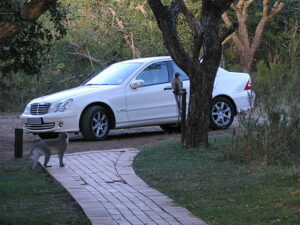
At one point, there were more than 15 monkies jumping on the car and from branch to branch and then onto our tent roof. It was scary.
Just as we were getting set to leave camp, we all got the feeling we were being watched. We were. Monkeys were coming to our campsite. Lots of monkeys! There were at least 15 of them. They were hopping from one tree branch to another and then to the roof of our tents. I looked out at the Thrifty Rental Car Racing Mercedes. There were monkeys on the roof!!
There were so many monkeys we were scared. We made a mad dash for the car. The monkeys scattered when they heard our racket. We would be returning to our campsite in the dark. We weren’t looking forward to that.
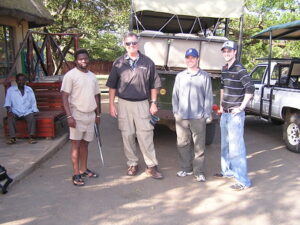
This was one of the most fun Trackchasing Tourist Attractions I’ve ever done.
This evening’s nighttime game drive would begin at 6 p.m. and go for 2.5 hours. Sunset was at about 7 p.m. This meant the beginning of the drive would be in daylight and the end in the darkness.
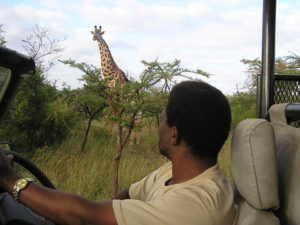
Ten passengers and the driver would be riding in our game tracking vehicle. I sat in the front seat with our guide. There were three rows of three in the back of the truck. The guide placed a rifle across the dashboard. We were off.
We would end up taking a 42-kilometer loop through the park. Some of the road was paved and some was not. We would be trying to spot Africa’s “Big 5”. The big 5 includes lions, elephants, leopards, water buffalo and rhinoceros.
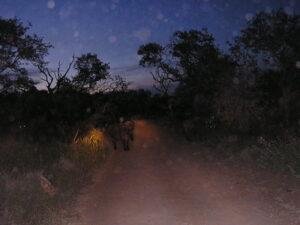
Check out all of those eyes looking at you. It was difficult to get good pictures at night, but it was exciting. These are water buffalo part of Africa’s Big 5.
We had special spotlights to help us see into the brush when it got dark. We saw several animals that weren’t part of the Big 5. These included impalas, zebras, wildebeests as well as eagles and owls.

This elephant was no more than 50 yards from us.
Probably the highlight of tonight’s drive was when we drove down by the river. It was still light out. Our guide was excellent at spotting animals in the distance. He spotted a lion. The lion was some 300-400 yards away. Nevertheless, we could see him/her prowling along a sandbar. Soon the first lion was joined by a second. The guide confirmed that the lion is “king of the jungle”. Elephants were everywhere.
Saturday, February 23, 2008
This morning began with a 5:30 a.m. game drive in Hluhluwe-Umfolozi Park. This was a private game drive dedicated to J.J., Will and me. Yesterday, we had seen three of the big five, including lions, water buffalos and rhinoceros. That left only the elephant and leopard to complete the list.
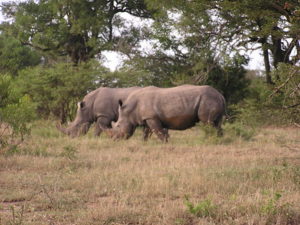
Our guide would be the same fellow who led our evening game drive the night before. Our original plan had called for a walking game drive this morning. However, last night I kidded our guide into showing up for a driving guide this morning. Maybe the prospect of earning a few extra Rand helped too. I figured we could see a heck of a lot more driving a 42-kilometer loop (about 25 miles) than we could by walking. We did have to meet a four-person minimum (there were only three of us) but that was a small price to pay for the exclusivity of our drive.
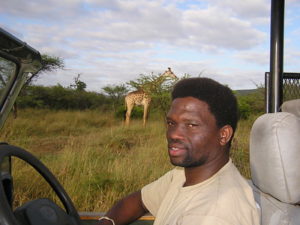
Our guide was fantastic. He could spot animals at great distances when no one else could see them.
Our guide was outstanding. He could spot animals far in the distance. I wanted to see the elephants. However, we had been driving for more than half of the tour without any luck. I kept joking with the guide and saying, “It’s time to see elephants now. There’s an elephant” (when it was obviously a rhinoceros). The guide knew we wanted to see some elephants but a game drive is like fishing. You never know what you will get.
With less than 45 minutes left in the drive, our guide spotted some elephants in the distance. Truth be told, we didn’t see them. He immediately put our truck in high gear and sped toward our prize. Normally we drove 10-20 M.P.H. as we searched for animals. We were reaching speeds in excess of 50 M.P.H. as he tried to get to where those elephants were before they moved again. I was just glad we didn’t come upon a heard of unexpected zebras standing in the road!
It wasn’t long before we saw our elephants close up. We were also able to see a small heard of them in the distance. We were told the park has 380 elephants spread over about 300 square miles. Shortly, after our elephant sighting, we finished our drive. Our stay in the park had been just perfect. We couldn’t have asked for more. We even saw a number of animals on our drive out of the park in our rental car.
With our morning game drive finished by 8:30 a.m., we had plenty of time to drive down to Richards Bay, a city on the Indian Ocean coast. This is where the Richards Bay Raceway, tonight’s racing venue is located.
I wanted to find the track as soon as we got into town, which would be about 11 a.m. I figured once we knew where the track’s location was we could find other things to occupy our time until the 6 p.m. start time. With some help from a local we met in McDonald’s, we got directions to the track.
I directed our group into Mickey Ds for two reasons. First, I wanted to see if they had any unusual items unique to South Africa on the menu. They really didn’t. Secondly, I wanted to buy some “kid’s toys” for a woman who works at the Pacific Golf Club and collects them. We ended up eating there as well. We all agreed it was the only bad meal we had in Africa. While we were in the restaurant, we got directions from a local. After he gave us the directions, he finished with, “I don’t think they’re racing there tonight. I haven’t seen an advertisement for the races”. This didn’t concern me too much. I had word from a South African racing fan who had phoned the promoter on my behalf to confirm they were racing.
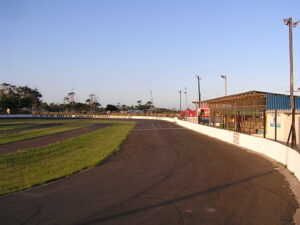
We showed up at the Richard’s Bay Raceway at the scheduled time of 6 p.m. To our shock and dismay, there was noboby there. This was very disappointing.
We found the track in somewhat of a county fairgrounds atmosphere. This was a small 350-meter asphalt oval. There was virtually no grandstand seating. Everything was clean as a pin. However, at noon there was no one there. No race cars, no people, no nothing. This concerned J.J. I told him I wasn’t surprised. The race meet didn’t begin until 6 p.m. I figured they would all start showing up later in the afternoon.
With that in mind, we drove further south in search of a hotel located directly on the Indian Ocean. We were about 2 hours north of Durban, the sight of tomorrow’s A1 Grand Prix event.
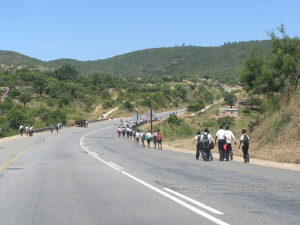
On the drive down there, we continued to encounter many pedestrians walking along the side of the four-lane highway. Much of the drive was along a toll road. We saw cattle grazing just 2-3 feet off the roadway with no fencing between them and us. It was surreal.
During our drives up to this point, we had seen residential developments dotting the hills and valleys of the rural areas we were driving by. Many of these dwellings weren’t much more than shanties.
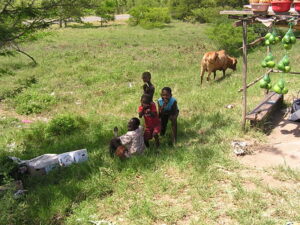
These guys were fun. I shared several African coins with them.
Will and J.J. are both Eagle Scout types (J.J. actually is an Eagle Scout and I wouldn’t be surprised if Will is as well). With this background, I think they may have been more than surprised when I pulled off the highway. I told them we were going to go exploring into these neighborhoods. We have sightseers driving by our neighborhood in San Clemente all the time. I didn’t see anything wrong with returning the favor.
I was surprised to find there were no paved streets connecting these houses. Once I pulled off the highway, it was all dirt roads. It’s very possible that three white guys in a Mercedes had never driven on these roads. We drove in about a mile or so and came across a small market.
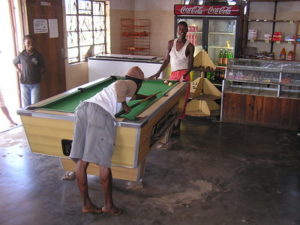
This little store had a pool table and not much else.
I asked the boys in they were thirsty. No, they weren’t. That seemed unusual, it was a warm day. I told them we were “going in” and with that pulled the car up to the entrance and shut off the engine. There were no other cars in sight in this dusty parking lot. Three teenagers were inside playing pool on a more than used up pool table inside the building. There were 4-5 smaller boys hanging around and a young woman operating the cash register.
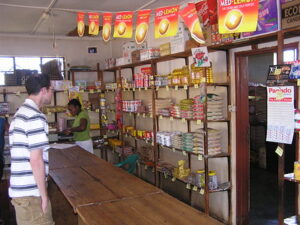
Will checks out the merchandise in this very basic store. Check out the red and yellow banners promoting cough and cold medicine.
I’m not sure if aliens with three heads would have drawn any more attention had they stopped for a Coke. The store was small, maybe 30 feet wide and 20 feet deep. The shelves were stocked with the basics. I ordered a Coke, but the boys still weren’t in the mood to make a purchase. I had only a 100 Rand bill (about $14). I gave the clerk that large bill to pay for my Coke. It took her some time to come up with my change. When she did, she gave me about 50 different coins. I think the Coke cost only about 3 Rand. With that, we were off. The boys breathed a sigh of relief….and so did I. They seemed a little bit surprised that I had left the keys in the Mercedes with the window rolled down while we were in the store. Truth be told, I was too!
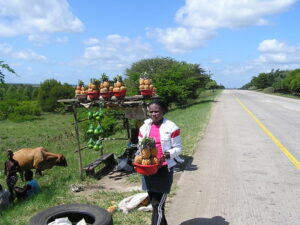
We passed a large number of roadside vendors during the trip. This woman was selling pineapples.
We continued our ride down the highway past several roadside vendors. We stopped at one woman’s stand and ordered pineapples on a stick. The woman used a machete to hack off the sides of small pineapples until only the fresh fruit was exposed. The treat was delicious. The price was only 4 Rand (about 60 cents) each. She had four small children with her, all lying under a tree with their cow. I distributed some of the excess coins to the kids that we had just received at the neighborhood market.
As we continued our drive, I asked J.J. to write down bullet points from the three of us about the trip’s activities and highlights. I didn’t want to leave anything out for each of the loyal and supportive readers to the Trackchaser Report.
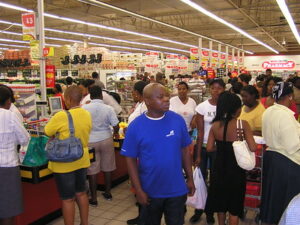
We stopped in this grocery store not to buy food, but so I could by my race ticket for tomorrow’s A1 Grand Prix in Durban. Can you spot Will? I got in trouble for taking this picture.
About this time, we had returned to Richards Bay for tonight’s race. However, before we could go there, we needed to stop at a Shoprite grocery store. They were selling tickets there for tomorrow’s Durban Grand Prix. The group’s website made it sound like tickets would not be sold at the gate, so it was important to buy my ticket when I could.
The boys would be coming along for tonight’s short track racing at Richard’s Bay. They would have a beach day while I went to the Grand Prix on Sunday afternoon. Neither of them is big race fans. I figured they would enjoy the small asphalt oval racing much more than being at a street circuit road course.
While I was standing in line at the Shoprite to buy my race ticket, I took the opportunity to take some pictures of the checkout area. This was one packed grocery store. People were wall to wall. I had only taken two pictures when a store manager came up and asked me what I was doing. I told him about all of the people who visit www.randylewis.org in search of photo insights of life on the trackchasing trail. He seemed non-plussed.
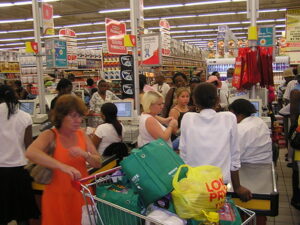
He told me, “I’m not calling you a scoundrel but with all of the burglaries and non-sense going on, we can’t allow you to take pictures without first asking permission.” I told him I fully understood his position. Sensing an opportunity, I then asked him if I could have his permission to take photographs. His answer? “No!” Sometimes, I just can’t win. Nevertheless, you the viewer of www.randylewis.org can see those banned photos. Just don’t contact that Shoprite store manager and tell him where you saw them.
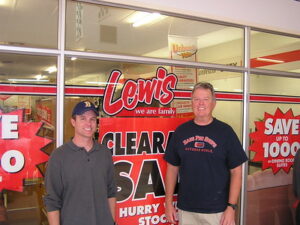
The Lewis chain of stores was everywhere throughout South Africa.
I had selected a ticket in the “silver” pricing section at the Grand Prix or 350 Rand (about $50). This was a mid-priced ticket for the race. Sometimes you can go to these events with the cheapest ticket available and sit anywhere you want. Then, sometimes you can’t. I didn’t want to buy a cheap ticket and be relegated to a position where I couldn’t move around.
With my ticket purchased, we were off to the Richard’s Bay Raceway. It was a gorgeous shirtsleeves weather late afternoon in South Africa. We pulled up to the track with the excitement of seeing my 1,315th-lifetime track soon to be realized. That was when the bad news hit us.
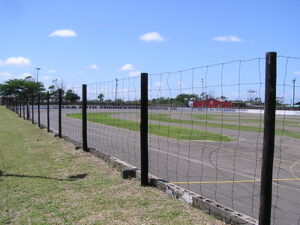
This 350-meter asphalt oval was similar to many tracks I have seen in the United Kingdom. I was really looking forward to my first ever trackchasing visit to South Africa.
There was still no one at the track. It was 6 p.m., the scheduled start time. For some unknown reason, they would not be racing tonight. I have made inquiries to my South African contacts as to why nobody showed up. If I get an answer, I will let you know.
I was disappointed. The boys were disappointed. J.J.’s premonition from this afternoon proved correct. Not knowing the trackchaser rules, the boys asked if they could run around the track so I could count it. I didn’t think the trackchaser commissioner would go for that. We were stymied. However, from a trackchasing point of view, I would still be adding South Africa. I would simply have to wait until tomorrow. I was convinced we had missed the best racing venue of the trip in not seeing short track racing at the Richard’s Bay Raceway.
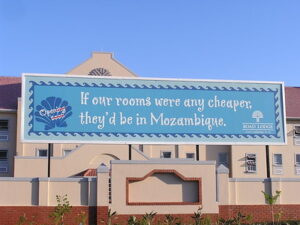
We also stayed a night in this Road Lodge Hotel similar to a Microtel in the states. We got a kick out of their billboard.
With that, we found a chain hotel in Richard’s Bay. It was brand new. Their huge billboard read, “If our room rates were any cheaper they would be in Mozambique”. I didn’t know what that meant but it didn’t sound like it was a compliment to Mozambique!
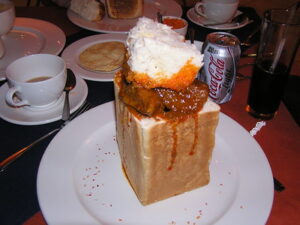
We made the best of our misfortune by having a grand dinner in this Indian restaurant. That’s bread that has been hollowed out on top. The main part of the break loaf is stuffed with curry chicken.
With our room secured, it was time for dinner. We found a very good Indian (Gandhi, not Sitting Bull) restaurant and made a nice evening of it despite our disappointment in not seeing a race tonight. Don’t miss the picture of my Indian dish on my website.
To be continued…………….
This brings to a close the first part of my two-part series on our South African adventure. It was a fun trip up to this point, but some parts of the trip were just about ready to get very exciting.
Thanks for reading about my trackchasing,

Randy Lewis
KwaZulu-Natal’s #1 Trackchaser
Walking is easy when the road is flat.
PART 2
DAY 12-15 – TO WHAT ENDS OF THE EARTH WILL I GO TRACKCHASING TOUR
AND THE READERS RESPOND
From time to time interested readers write to me about one thing or another. Many times, I feel that my other readers would be interested, informed and/or amused by the comments I get. Here’s what a South African reader had to say about Part 1 of my African Trackchaser Report series:
“Hi Randy,
I had a look at the photos on your site and have to admit it does look like it was a lovely trip! It is interesting to read your comments on what you saw and experienced, and I realized that things we hardly take note of (like the ever-present high wrought iron fencing) is noticeable for someone from the “outside”. Generally, the rural areas of SA are very safe and the people tend to be a lot friendlier and more accommodating than in the cities. Just 1 (probably ignorant) question: did you go to Senegal because you wanted to visit the country, or was it simply a forced stop-over on your way to SA?
It seems the racing at R/Bay Oval was canceled due to a lack of basically everything: drivers, spectators and officials. Maybe the A1 was just too much competition for them? Natal isn’t a very populated area, and having any big event (like rugby or cricket) on the same evening can have quite an effect on the number of people that attend the oval events. I’m glad to see that you found a substitute for the racing: curry restaurants in Durban and up the coast are known for their good food. You probably know this, but the loaf of bread filled with curry that you had is known as a “bunny chow”. I heard this is the English version of the name for a dish which literally means “commoners food” due to its wide-spread popularity with the masses in India (although I doubt they would have used a loaf of bread). If this is true I must be a commoner, since it is also one of my favourite meals, but unfortunately you have to hunt far and wide for a proper bunny chow in Gauteng.
I will be keeping an eye out for part 2 of your report. All the best with your hobby!”
TODAY’S HEADLINES
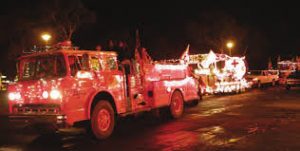
Tonight we survived an emergency airline landing. I’m happy to be able to tell you that!……………….more in “Monday, February 25, 2008”.
We had the wildest hotel negotiation in recent memory in Johannesburg. You won’t want to miss it …………..details in “Monday, February 25, 2008”.
See the grade I gave today’s racing, the overall event and my overall experience in South Africa. …………..details in “Race Review”.
Greetings from Durban, Kwazulu-Natal, South Africa, Africa.
We’ve spent the last several nights in Africa since leaving New York City. I woke up in Richard’s Bay, Kwazulu-Natal, South Africa this morning. I went to sleep in Ballito, Kwazulu-Natal, South Africa. This is what transpired over the second half of our African continent trackchasing adventure.
The Purpose
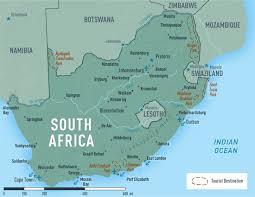
One of my primary trackchasing objectives this year is to see racing at racetracks I have never visited in foreign countries. Today’s new track was in a very far away place, South Africa. The trip would require more than 20,000 miles of round-trip air travel. When I go trackchasing in a foreign country, my main purpose is to see the country and experience its culture and people. The race I will visit is what motivates me to visit the country. However, the race is far down the list in the overall importance of the things I want to see and do for my personal enjoyment.
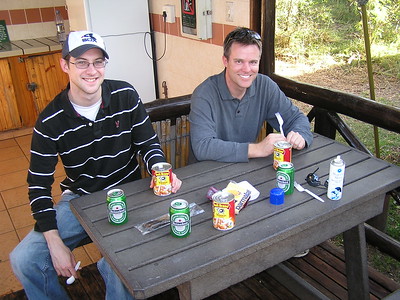
Will and J.J.
I would be accompanied by my son, J.J. and his friend (and now mine) Will Van Horne. We were a great threesome. We all love adventures like this one. Although you couldn’t come along for this particular trip, I want you to have just about as much fun seeing and “doing” South Africa as we did. So sit down, strap on your seatbelt and imagine yourselves traipsing around South Africa as we did for a week. I hope you enjoy the ride and suspect it might be a bit safer but maybe not quite as exciting as actually being there.
Sunday, February 24, 2008
This was a simple day. It was pretty much, have breakfast with J.J. and Will, then go to the race and have dinner with the guys upon my return. The plan had been for J.J. and Will to join me at the short track race last night in Richards Bay. Then they would spend the day at the Indian Ocean beach on Sunday while I went to the Durban Grand Prix.
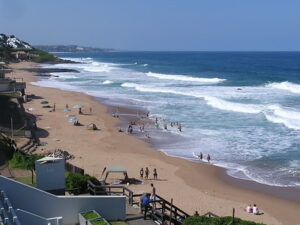
We spent the afternoon in Ballito an oceanfront town in the province of KwaZulu-Natal. This is the Indian Ocean. We stayed here for what was scheduled to be our last night in Africa.
However, the racing plan for J.J. and Will changed when the promoter and racers did not show up at Richard’s Bay. Neither of the boys is a big race fan. I’m not much for dragging people to the races when it’s not something they enjoy. I didn’t do that when our children were smaller and I wouldn’t want to start now.
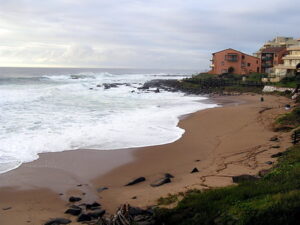
This was the view from our room in Ballito, NwaZule-Natal, South Africa, out last planned night of trip.
Our hotel for today is located directly on the beach. Our room is just a few yards from the crashing waves. With the weather so beautiful and temperatures at about 80 degrees, I wished I could have a beach day rather than going to the race today. However, I came to Africa so I could get a new trackchasing country. With last night’s “no show”, I had no choice, I had to go to the Durban Grand Prix.
I’ll tell you more about the race in the “race review” section of this Trackchaser Report”. I was able to get back to the hotel after the race by about 6 p.m. I was just in time for a margarita poolside. We followed with a nice dinner in downtown Ballito.
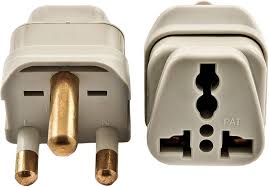
I’ve discovered that African electrical adaptors require plugs that accept three circular male prongs set in a triangular configuration. My “world” electrical adapter didn’t have this connector. I was lucky to be able to get an African adapter from the hotel’s front desk. The clerk told me he would charge a deposit to my account in case I “forgot” to return the adapter.
The next morning I was reminding myself of how valuable this adapter actually was. Maybe I would need this electrical configuration on future foreign country visits. When I went to return it to the front desk, I asked the clerk how much I would be charged if I did not return it. He told me 20 Rand. That’s only about $3. “I didn’t return the adapter”, I told him. He knew what my intentions were. Buying this adapter for three dollars was a literal steal.
Tonight was our last night in Africa. We had an early morning wake-up call and then a 5-6 hour drive northward to Johannesburg. This had been a great trip in every way imaginable. Little did we know it was not going to end as soon as we expected.
Monday, February 25, 2008
Today, we would be heading home. Although the trip would be long (almost 11,000 miles), it seemed like it would be straightforward. Our plan in its simplified version was this.
Drive from our hotel in Ballito, KwaZulu-Natal to Johannesburg (about 6 hours).
Have about three hours to return our rental car and clear airport customs, etc.
Fly 17 hours from Johannesburg to Washington, D.C. landing on Tuesday morning at 6 a.m.
We spent about two hours clearing U.S. customs and changing terminals for a flight back to Los Angeles.
Fly 5 hours from Washington, D.C. to Los Angeles.
Once in Los Angeles, Trackchasing’s First Mother would pick me up for our one-hour drive home.
Overall, this version of our return was planned to take 37 hours. We would fly about 10,500 miles. We would drive about 400 miles. We would clear customs in both South Africa and the United States. This simple plan was if everything went off without a hitch. As you might imagine, if you have read this far, the fun was just getting ready to start.
Here is what actually happened.
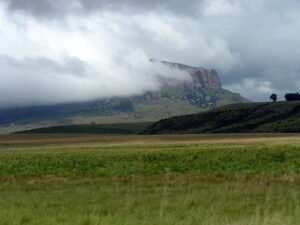
The scenery on our drive to Johannesburg was the most unusual of the trip.
Our drive from our Sunday night hotel situated directly on the Indian Ocean in Ballito to Johannesburg was uneventful. We traveled over very hilly terrain and mountainous roads as we headed north on the N2 Tollway. The surroundings were lush green in color. We did not see nearly the amount of pedestrians walking along the roadside as we had earlier in the trip. We did run into rain for about 20 minutes. This was the only rain we encountered during the entire trip and this is supposed to be the rainy season. Things were going so well, we arrived in Joburg two hours earlier than expected.
This gave us time to take a quick tour of downtown Johannesburg. Joburg has about 3.2 million people. About 69% of the residents are black, 22% white, 6% coloured and 3% Asian according to census data.
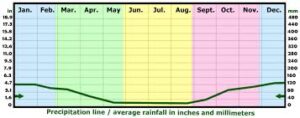
The average July temperature is 61 degrees and the average January reading 77 degrees. Their seasons are the opposite of ours in the states. January is the rainiest month of the year with an average of 4.90 inches falling. July and August are the driest months with just 0.20 inches of rain.
Once in Johannesburg, we found a place to park on one of the city streets and set about on foot looking for a place to eat lunch. The population that we saw today in Joburg was nearly 100% black. It is also a very crowded city. If you would imagine the look and feel of a major United States inner city location such as Chicago, you might have the look of downtown Joburg. It was a lot different from our cozy dinner in suburban Joburg a few nights earlier. Of course, pictures of this scene and all the rest of our trip appear at www.randylewis.org.
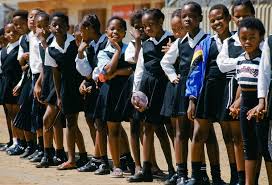
We walked several blocks in different directions. We couldn’t find any place, other than a couple of fast food looking joints for lunch. That being the case, we simply took in the sights. The one most notable memory I will have of the city was the crowded conditions as well as the hustle and bustle of the city. We saw a good deal of school children all neatly dressed in their colorful school uniforms. During the one hour we spent on the ground, I saw one other white person. We must have looked like Mormon missionaries!
Our drive out of the city was just as interesting. Three white guys in a white Mercedes reminded me of my visits to South Carolina or Montana or most of the places I go to. The phrase “you aren’t from around here are you boy?” rang in my head.
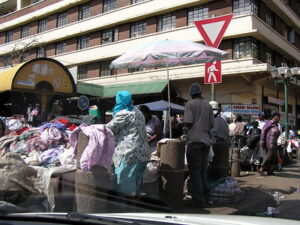
Joburg was teeming with people.
We drove through some of the most congested people and vehicular traffic I have ever encountered. There were times when the people surrounding us at pedestrian crossings were as thick as those surrounding a presidential motorcade. God forbid if we had run over anybody.
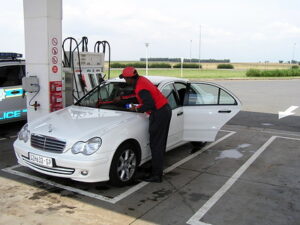
South African gas stations do not take credit cards. However, they give full service attention to your vehicle and expect a tip.
Following that fun and interesting trackchasing experience, we made our way back to the airport. We needed to fill the car with gas but soon learned gas station operators didn’t take credit cards! Returning the car, with 2,051 kilometers on it was just about as easy as it would be in the United States. Getting our boarding passes and clearing South African customs was a breeze. Our return trip was going far too well.
The next step was to clear airport security. In many countries outside of the United States, passengers do not have to remove their shoes and take out “gels and liquids” as they do in the U.S. I did have to remove my laptop computer from my computer bag.
I spent some time buying souvenirs to supplement what I had already purchased for my loved ones. Then I paid 30 Rand (about $4) for 30 minutes of internet time. I wrote to Carol that things were going swimmingly and I would be home on time as planned.
Our flight tonight was scheduled for a 6:20 p.m. departure. We would be flying back to Washington, D.C. on South African Airways. We would first fly from Joburg to Dakar, Senegal (remember Senegal is one of Africa’s 47 individual countries). That flight would be more than eight hours long. We would stop in Dakar for an hour, without getting off the plane, before flying nine hours to Washington’s Dulles airport. I thought it was pretty cool that Dakar, Senegal in Africa is closer to New York City than it is to Johannesburg, South Africa.

We boarded our plane. Not long after boarding, the power went out on the plane and everything went dark. Soon the pilot came over the P.A. and explained that a lightning strike had hit the tarmac and possibly blown one of the three batteries used to power the plane’s electrical system. He would have maintenance come on board to check things out.
We waited on the plane’s maintenance personnel for an hour or so. Apparently, the problem was fixed. We would be taking off. Just as we began to move down the runway for takeoff, a burning smell permeated the interior of the plane. To me, it smelled like an electrical fire. Later others would swear it was jet fuel burning. Although it was annoying, it didn’t seem that bad to affect our flight.
We were up in the air for about 15 minutes when the cabin went dark just like it had done before takeoff. We flew for another few minutes with no explanation. Finally, the captain came over the P.A. again and informed us that he had bad news. That is never the kind of pilot P.A. you want to hear after the lights have gone out.
His cockpit instruments were not looking good he told us. There seemed to be an “irregularity” in the electrical system. We would be returning to Johannesburg. That was a bad sign in more ways than one. This would blow all of our connections back in the states. They might even cancel the flight. This could delay our trip by as much as 24 more hours.
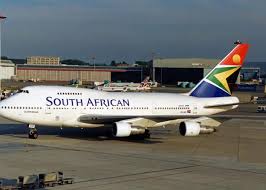
The captain soon came back to us with even more unsettling news. He would be dumping fuel. He told us the senior flight attendant would give us further instructions. It took several minutes for us to get rid of the fuel. We would end up dumping 27 tons of jet fuel. At eight pounds per gallon, you can do the math.
We were told we would be making an emergency landing. Both J.J. and Will are commercial airline pilots. They had never been part of an emergency landing. I might have had one before, but I cannot remember when or where.

The crew took us through what our emergency landing would entail. The captain kept telling us that he was simply following procedure and no one should be unduly alarmed. I looked at the woman sitting near me. She was unduly alarmed! This wasn’t how those Dreaded East coast Trackchasers were going to catch up in the worldwide trackchaser standings was it?
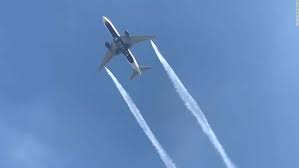
Before our final approach, the captain told us we had dumped all the fuel that was needed. We had to dump this fuel, he explained, so the plane could be at the proper weight for landing. He told us that they had landed planes safely at this maximum weight several times. He didn’t say if they had tried to land planes UNSUCCESSFULLY at this maximum landing weight.
With the runway lined with fire trucks and flashing red lights, befitting any disaster airline movie you have ever seen, the plane made a perfect landing. Nearly everyone clapped and cheered. If that wasn’t enough excitement, the fun was really about ready to begin.
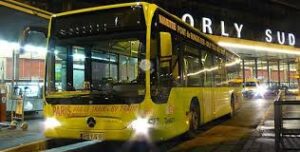
Once the plane did land, passengers were placed on two large buses for a ride back to the terminal. We were told the airline’s maintenance staff would look at the problem and get back to us.
In somewhat of a surreal scene, in order for all of the passengers to get back into the terminal, we had to clear airport security again. Once that was done, everyone was relocated to a large self-serve restaurant to await further word. It was now past 10 p.m. We were now four hours past our scheduled take-off time. Our planned schedule was rapidly falling apart.
It is times like these where J.J. and I see the opportunity to separate ourselves from the pack. I approached one of the restaurant employees and told him of our situation. I told him that I expected South African Airways (SAA) would be providing some food and drink for the stranded passengers. He agreed and directed me to grab the same. I did. Soon the three of us were dining on bottled O.J. and French pastries. The other passengers looked at us in envy. They soon recognized the opportunity and helped themselves. It’s not hard to imagine folks looting stores during riots and hurricanes like we continually see on TV. Of course, all of our “looting” was done with full approval.
After some time, an SAA employee came along to give us an update. The plane would not be flying tonight. We would leave tomorrow at 11 a.m. It was good to know we had a firm departure time. Now, where we would stay for the night? The SAA rep told us they had been checking for hotels and none could be found. The 150 passengers could sleep in the SAA airport lounge overnight. That didn’t sound like much fun to me.
I pulled the airline rep aside. Could we find our own hotel and be reimbursed by the airline? I was told we could. J.J. grabbed my laptop and found a secluded spot in the airport and went to work finding us a place to stay. My recently purchased African electrical adapter was already paying for itself. He bought 30 minutes of internet time. He communicated with his work and told them he would not be back on time for his flight schedule. Then he searched for hotel sites and found us a room. Just as he was paying for it, our internet time ran out and the connection went dead! If it wasn’t for times like this, trackchasing would not be this much fun.
By now, the passengers were beginning to freak out in various forms. Some folks were from Joburg. They simply turned on their cell phones and called family and friends. Others had no phones and no internet connections. These people were destined to sleep overnight on the floor in the airport. Information and technology rules despite what the Unabomber thinks!
Finally, we made an internet reconnection and secured a room at a hotel a few miles from the airport. The website told us the hotel had a shuttle. Please don’t confuse this arrangement with any such experience you’ve had in the United States. It wasn’t like that. Nevertheless, we were off. However, we couldn’t just walk out the door of the airport to the outside. We had to go through a maze of hallways that finally led us to the South African passport control area. It was as if we had just landed on a plane from a foreign country into South Africa. At least we were building up passport stamps at a rapid rate!
It was now nearly midnight. Once we were through passport control, we had to battle a hoard of taxi drivers who wanted to take us to the hotel. Our plan was to take the airport shuttle. One particularly outspoken driver told us there was no airport shuttle. We didn’t believe him. We tried to phone the hotel by using a payphone. Have you ever tried to use a payphone in a foreign country? It requires a full semester’s class to understand the process.
We didn’t make contact, but two woman salesclerks in the nearby gift shop tried to help us. I don’t know if this makes a difference in the story to you at this point, but 100% of the people we were talking to during the entire evening were black South Africans. Some were helpful and some were not. I guess it was about what you would expect from people just about anywhere.
We could not contact the hotel through the payphone. The persistent taxi driver offered to call the hotel with his cell phone. We tried that but the hotel did not answer our call. We ended up agreeing to go with the cab driver. Like good tourists, we had spent all of our local currency, the South African Rand, before getting on the plane. Now we had to visit an ATM to get money for our taxi fare.
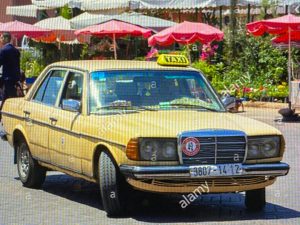
Our driver had a beat-up old Mercedes. After all of our bags were placed in the trunk, we hopped in the car. It wouldn’t start! Oh my, what else could happen?
Finally, after a good deal of car battery groaning, the engine fired. We were off. We arrived at the hotel. It was 11:15 p.m. We entered the lobby and told the clerk about our reservation. This was when the most fun of the night was about to begin.
Here’s the situation. We have the desk clerk. We have an animated taxi driver. We had the three of us. Soon other character actors would join the performance. We did not have a printout of our reservation details. However, we did have the hotel reservation details on my laptop. I am always grateful for the benefits of my computer on the road. This was just another example of “being wired” as a major benefit.
Were we shocked when the desk clerk told us she had no rooms? We told her we had a confirmed reservation. Just about this time, our aggressive taxi driver noticed another opportunity. He might be able to drive us to yet another hotel! He had also noticed that one of the bills we had used to pay him was torn nearly in half. He was making a racket that we needed to give him another bill. We didn’t have any more bills.
The conversation was beginning to heat up. The clerk was adamantly explaining that her system did not show our reservation. J.J. and I were just as adamantly pushing the point that our reservation details were right there on our computer screen. The taxi driver was yelling about his torn Rand bill.
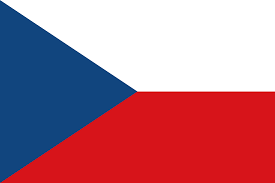
Just when the scene could not get any worse or funnier, depending upon your point of view, more people joined in. First, there was a fellow from the Czech Republic in a grey sweatshirt hanging around the front desk area. He was about my age. Apparently, he had trouble with an earlier SAA flight cancellation and had been given five rooms for all members of his family. He entered the conversation in English with a Czech accent.
He kept telling us “I have one room for my wife and me. I have one room for my son, I have one room for my other son, and I have one room for my daughter and one room for my other daughter”. He must have repeated this conversation ten times. At one point, I asked him how much he would charge us for one of the rooms. He told us he would give us a room for half-price. He had gotten each room from the airline for free!

All the while this circus was going on Will was over on a sofa doing his best “Silent Bob” impersonation. As the conversation went first one direction and then another, Will’s face would contort to either support or vilify the points being made.
The hotel clerk was on the phone with both her manager and the manager of a nearby hotel in the same chain. This hotel lobby process had been going on for 30 minutes.
According to the clerk, there were no rooms for us to have. According to the Czech guy, his final offer was “I will give members of the United States a room for free”. The taxi driver was quoting fares to other hotels. Finally, the hotel clerk told us another hotel in their chain had room for us. We were concerned we would be charged for the room that we had not gotten and would have to pay for another room at the next hotel.
The clerk told us that the other hotel that did have rooms was close by. The taxi driver quoted us a fare of 280 Rand. That was about $40 U.S. The clerk immediately told us we could go there for 80 rand (about $12). We kicked the taxi driver in the butt and he left the building.
By now, the clerk wanted to kick us in the butt and get us out of the building. Just at that moment, about 10 people entered the lobby. Their flight had been cancelled and the airline had given them rooms at the hotel. The clerk happily began to check these folks in. That did not sit well with us.
Nevertheless, we secured another cab driver, Carter, who took us to our new hotel for a fare of 80 Rand. The new hotel turned out to be the Don Suites hotel where we had stayed on our first night in South Africa. It was now past midnight. We should have been in the air for nearly six hours by now, but we weren’t. Carter, our driver, promised to pick us up at 9 a.m. the next morning (he didn’t).
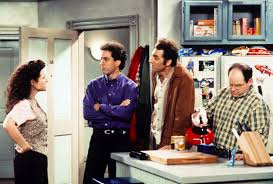
By the time I got to bed, it was past 1 a.m. What a night! These trips would make great Seinfeld sitcom material. We had survived an emergency landing. We had had some experiences we will likely remember for a lifetime. This is all in the life of a trackchaser.
Tuesday, February 26, 2008
Today our flight was scheduled to leave at 11 a.m. Even though we had been on the plane the night before, it was as if we were brand new passengers all over again. This meant a visit to the ticket counter for new boarding passes. Then we went into a separate line to get reimbursed for last night’s hotel. They would not pay for our taxi fares because we had forgotten to get receipts. They did pay for our breakfast.
Next, we had to clear South African customs again. There were 6-7 times in the entire process when our passports and/or boarding passes were checked and re-checked before we boarded the plane. I have never seen this done so much anywhere.
The Don Suites Hotel had given us a very nice bottle of South African white wine for all of the trouble that we had encountered. That was nice of them. The airport security staff took it away from us! You win some and you lose some.
Our plane departed an hour later than the revised schedule at noon. At least we were off. I had 22 hours of flying ahead of me. The first 17 hours of flying would only get me as far as Washington, D.C. From there J.J. and Will would fly to Chicago where they live. I would continue onto Los Angeles.
We landed at Washington’s Dulles Airport at nearly midnight. I had already reserved a hotel via Priceline.com near the airport. The boys elected to sleep overnight in the airport and head back to Chicago on a 6 a.m. flight.
I guess I might have done that in the past, but there was no fire to put out at home. I could afford to get a good night’s rest and make the 5-hour flight during the daytime hours. I bid the guys farewell after we cleared U.S. Customs in D.C. It would be great to travel with both of them sometime in the future.
Wednesday, February 27, 2008

As I waited for our plane to depart this morning at 11 a.m. I noticed a young red-headed woman who had been on our flight from Johannesburg to Washington. I remembered her mostly for the uneasiness she showed during our emergency landing. I don’t blame her for being scared, several people were.
She seemed to recognize me as well. She came over to say hello. This woman was a native South African. She was a preacher’s daughter, probably in her mid-20s with two young daughters and a husband. The family lived in Los Angeles.

She had come to the United States as a nanny. She met her future husband three days after she arrived in the states. Just two days later, he asked her to marry him and five weeks later, they were married! She told me that the phone call to her father explaining these events was a most interesting one.
What made her story all the more unusual was that her father had met her future husband 18 months before she did. He actually recommended that she meet the man once she arrived in the United States. And, as they say, the rest is history.
This woman went on to tell me about life in South Africa. Mind you, this is just one data point. Because one person offers an opinion that does not necessarily make their point of view true. Nevertheless, she told me that South Africa has really gone downhill over the past 5-10 years. Her parents were strongly considering relocating to the United States. She told me that electricity is in such short supply that every afternoon the power is shut off for a few hours. Crime is bad. We did see the dramatic amount of iron gates, steel bars and security guards everywhere we went. We didn’t feel safe in Senegal, but we did feel safer in South Africa. I know that several South Africans who gave me information about the planning process for this trip are reading today’s report. Maybe they will provide their point of view.
By the way, here’s some additional information I came across on South Africa. It might put the previous observations in context.
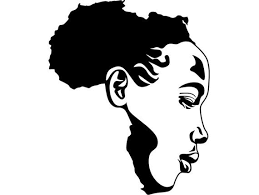
SOUTH AFRICA – FAST FACTS – COUNTRY INFORMATION
South Africa is a vibrant and diverse country that has experienced quite a different evolution to other African countries. Often referred to as the ‘Rainbow Nation’, South Africa has no single culture, a characteristic that makes it all the more interesting country to visit. Tourists in particular can enjoy this diversity, which is presented in South Africa’s cuisine, music and dance, which all feature prominently in South Africa’s culture.
While South Africa’s diversity may be less of a problem now and even celebrated by most, it has caused political difficulties through the country’s history.
For most of the seventeenth and eighteenth centuries, the expanding settlement known as South Africa was under Dutch and later British control. The discovery of diamonds and gold in 1867 and 1886 obviously increased interest in the region, as well as encouraging economic growth. Conflict continued through this period, as the British fought the Boers for control of the region, through the first and second Boer wars. After a series of military defeats, the British finally succeeded in taking control of the region. In 1910, the Union of South Africa was created from the colonies of Cape Colon, Natal Colony and the republics of the Orange Free State and the Transvaal.
Political division between the two main parties during the Second World War, saw the country emerge in the post-war period with the right wing National Party in control. The National Party implemented a series of racist laws that became known as apartheid. Apartheid led to oppression and a wide division in living standards and widespread sanctions and divestment abroad. Unable to control the growing violence and protest within the country, the National Party took the first steps to negotiate itself out of power in 1990. Lifting the ban on the African National Congress, and other left-wing parties and the symbolic release of Nelson Mandela showed how the country was changing. As apartheid was gradually removed, the first free elections were held in 1994, giving black people the opportunity to vote for the first time.
Now in a more peaceful period, South Africa is able to concentrate on a developing economy. A middle-income country, South Africa has an abundant supply of resources and a well developed financial, legal, communications, energy, transport sectors and a stock exchange which is among the 10 largest in the world. In fact the South Africa Rand was the best performing currency against the US Dollar between 2002 and 2005.
I was home!
It was late afternoon by the time Carol picked me up when I landed at LAX. I had been gone for two weeks. Time flies when you’re having fun. I had spent the first five days of the trip with Carol touring the Northeast and New York City. The balance of the trip had been spent with my son. It doesn’t get much better than that. I have a terrific family and a terrific hobby that takes me all over the world. I couldn’t really ask for anything more.
COUNTRY RANKINGS
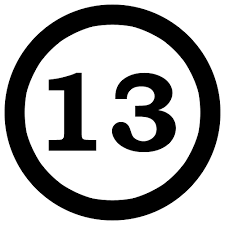
South Africa
I am the first unpaid trackchaser, according to www.trackchaser.net, to ever go trackchasing in South Africa. I guess that rightfully makes me “South Africa’s #1 Ranked Amateur Trackchaser”. There have been eight other people who have recorded trackchasing visits to this faraway place. However, each of those folks was either a driver racing in the race or a journalist reporting on the race. Amateur trackchasers, don’t be afraid. Come on down to South Africa, you’ll love it.
Trackchaser commissioner Will White has offered me a challenge in foreign country trackchasing. Mr. White is the leading U.S. based trackchaser in seeing races in foreign countries. He has seen racing in 20 overall countries, an impressive total.
With the addition of South Africa, I have now seen racing in 13 different countries. Will has offered to “Race You To 30”. I know Will’s offer smacks of direct trackchaser competition and some trackchasers would rather smack their mother in the face than have anyone think they were actually competing in the hobby of trackchasing.
Personally, I am not going to hold Will’s offer against him. I am not offended by it at all. I will accept Will’s offer for a friendly competition. I know it will take each of us some number of years to reach our goal of seeing racing in 30 different countries. Regardless of how our competition turns out, I know that each of us will have the time of our lives trying to add foreign countries to our trackchasing resume.
RACE REVIEW
SPECIAL NOTICE!
This afternoon I saw racing in my 13th different country. Below is a list of when and where I saw first saw racing in each of these countries.
13
SUMMARY OF “COUNTRY” TRACKCHASING ACHIEVEMENTS
# 1 – UNITED STATES OF AMERICA – Peoria Speedway (Mt. Hawley) – Track #1, Peoria, Illinois – circa 1954 (age 5)
# 2 – CANADA – Cayuga Speedway – Track #174, Nelles Corner, Ontario, Canada – July 31, 1988 (Dick Trickle winner)
# 3 – UNITED KINGDOM – Northhampton International Raceway – Track #378, Northhampton – June 26, 1999 (accompanied by Carol, Kristy, Jim)
# 4 – AUSTRALIA – Speedway City – Track #804, Virginia, South Australia – December 26, 2004 (accompanied by Carol)
# 5 – NETHERLANDS – Driesum Racetrack – Track #839, Driesum – May 5, 2005 (accompanied by Roland Vanden Eynde)
# 6 – BELGIUM – Bellekouter oval – Track #841, Affligem – May 8, 2005 (accompanied by Roland Vanden Eynde)
# 7 – FRANCE – Circuit de Croix en Ternois – Track #843, Saint-Pol sur-Ternoise – May 8, 2005 (accompanied by Roland Vanden Eynde – 2ndnew country in one day!)
# 8 – GERMANY – Nurburgring – Track #844, Nurburg – May 13, 2005 (accompanied by Carol, Roland Vanden Eynde)
# 9 – NEW ZEALAND – Western Springs Speedway – Track #1,134, Western Springs – December 26, 2006 (accompanied by Carol)
# 10 – MEXICO – Triovalo Bernardo Obregon – Track #1,281, Tiajamulco de Zuniga, Jalisco – October 14, 2007 (accompanied by Carol, J.J., Roger Ward)
# 11 – BARBADOS – Bushy Park Racing Circuit – Track #1,296, Bushy Park – December 9, 2007
# 12 – THAILAND – Bira Circuit – Track #1,300, Pattaya – January 19, 2008
# 13 – SOUTH AFRICA – Durban Grand Prix – Track #1,315, Durban, KwaZulu-Natal – February 24, 2008
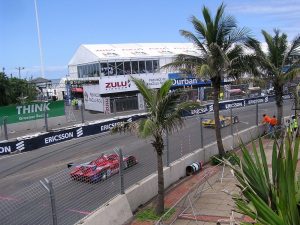
My view of the racing today
DURBAN GRAND PRIX (ROAD COURSE), DURBAN, KWAZULU-NATAL, SOUTH AFRICA
As mentioned, I bought my race ticket for today at a supermarket in Richard’s Bay. I paid 350 Rand for a seat in the Silver stands. Here’s what the ticket-pricing schedule looked like:
Platinum Stand: R650.00 (does not include Pit/Paddock access)
Gold Stands/Disabled Stand: R450.00 (does not include Pit/Paddock access)
Silver Stands: R350.00 (does not include Pit/Paddock access)
Bronze Stands: R250.00 (does not include Pit/Paddock access)
Unreserved Picnic Area: R160.00 (no seats provided)
Here’s some background information I found about today’s event and racecourse:

How’s this for narrow!
“The street circuit in Durban was specifically designed for A1GP and held its first race in January 2006. The tight twisting circuit, leaves little room for error and is considered to be one of the most difficult circuits of the season.
The 3.2-kilometre (2.0-mile) layout has its start/finish line opposite Natal Command in Snell Parade, lying between Natal Command and the beach. Running in a clockwise direction, cars blast down to a very tight right-hand hairpin out of which the cars then accelerate back up Snell Parade and then snap left into Argyle Road with a left/right chicane.
Average February temperature: 24.5°C (76.1 °F)
Average February rainfall: 127mm (5 inches)
Track length: 3.28 km (2.04 miles)
No. turns: 11
Direction: Clockwise
Lap record: 1m 18.178s recorded by Nelson Piquet Jr, A1 Team Brazil in 2006.
Please collect your tickets from any Computicket, Shoprite, Checkers or Checkers Hyper store before the event as there will not be collection facilities at the venue. Please remember that you must present the same credit card used to make the online booking at the outlet when collecting.
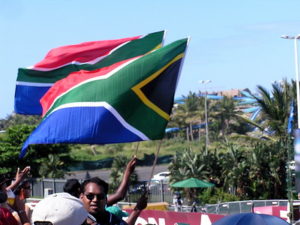
The South African flag!
I arrived at 11 a.m. just in time for the first race of the day. I had parked, for a fee of 20 Rand, in a grass field a little less than a mile from the track’s entrance. I wasn’t very comfortable leaving my laptop in the trunk, but I didn’t have much choice. Unlike similar situations in the U.S., they did have a guard watching over the parked cars.
Today was a warm day with temps in the 80s. There was no chance of rain. It didn’t matter if it rained anyway. These types of road races will run in any type of weather.
Before I go any further I will tell you this. Today’s racing gets a grade of “F”. The event gets a grade of “B”. That’s about what I expected, but then you never really now.
I did not realize it when I parked but I was on the opposite side of the 2.0-mile course from where my seat in grandstand 3 would be. That wasn’t a major problem as it encouraged me to explore every nook and cranny of the entire area.
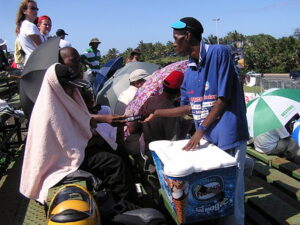
I was sitting in this grandstand. On such a warm day, the use of umbrellas only added to sightline problems.
It didn’t take long to find a large area where refreshments were being sold. I love going to foreign countries where different foods are offered, especially at racetracks. The popular item of the day seemed to be “mutton burgers”. I was glad I wasn’t hungry.
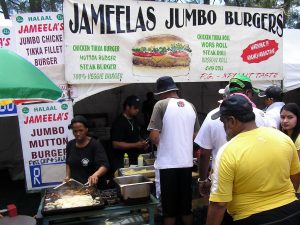
I love track food, but I draw the line at mutton burgers!
Today’s racetrack is a “street course”. That means they shut down a portion of the downtown city streets, erect safety barriers and hold a race. The drawback for the spectator is that virtually none of the racing can actually be seen. There were high-rise buildings inside the track area, shopping centers and just about everything else.
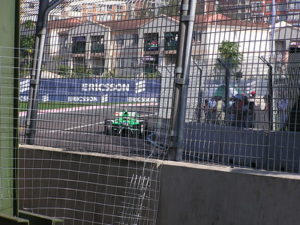
Imagine your hometown having a race on a two-mile loop through downtown. Would you be able to see much? Probably not.
The first race was a 20-minute affair that started at 11 a.m. The main event of the day didn’t start until 3 p.m. This gave me more than enough time to explore things. Soon, I found myself in a large and modern indoor shopping mall. It was here that I had lunch….calamari at a place called Wimpy’s. Remember all of this activity was on the INSIDE of the temporary street circuit racecourse.
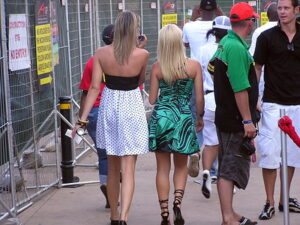
The dress code was all over the board. I bought an event shirt like the fellow in the red hat is wearing.
There was also a “full-on” Las Vegas-style casino on the premises. In order to get past security, I had to remove my hat. I plunked down 50 Rand (about $15) and played a few hands of blackjack. Soon I had nothing. They don’t build these beautiful casinos because the house loses money.
My race ticket would allow me to enter some areas of the overall facility but I was rejected as other points. The track personnel would place my ticket in a card reader. If the light turned green, I was allowed to pass, if not I had to try another entrance.
Downtown Durban sits right on the eastern coast of South Africa and the Indian Ocean. It’s a beautiful location, but the city does have a reputation for being rough on tourists from a security standpoint.
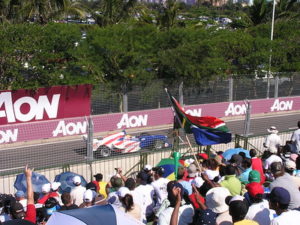
After exploring the grounds completely, having lunch and taking in some sun at the beach it was time to find my seat. This was no easy task as the grandstands were not numbered. Finally, after stopping at several grandstands, I found mine.
I went up about 25 rows of the 50-row temporary bleacher area. I sat down. I looked forward to the track. Wow! I could see a straight portion of the track that was maybe 300 yards long. This part of the track was extremely narrow, maybe about two car lengths wide.
This meant two things that I soon realized when the cars began to race past. First, I could see the cars for about four seconds from the time they came into view until they drove out of sight. That’s four seconds out of about a 75-second lap. Of course, there was absolutely no passing during the four-second period on such a narrow track.
I currently rank third in the world in road course racetracks seen. I’m surprised I’ve seen that many considering how I feel about not being able to see the racing action. Today, my grandstand was nearly full. Had these people had frontal lobotomies and a good plastic surgeon to cover the scar?
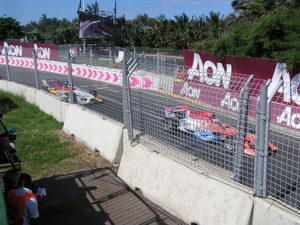
This is the only street circuit on the entire A1 Grand Prix schedule. The sightlines were bad.
Who in their right mind would pay 350 Rand to sit for hours out in the hot sun only to see the cars come by for FOUR SECONDS? This is a question, I do not have an answer for.
I only stayed in this location for a few laps. I was probably three miles from the car. I began the walk toward the parking lot stopping at each little spot where I could get a view of the race. This was actually a much better way to see things than staying in my grandstand seat.

The A1 Grand Prix sanctioning group is a winter racing series. This season spanned 2007 and 2008 with 10 races in 9 countries. Their format is unique. They have one car representing each of 22 different countries. Each country’s car is painted in the colors of that country’s flag.
They don’t promote the driver, but the country. The announcer will tell the crowd that “Germany just passed France for second place” as an example. I’ve never heard of such a thing, but I think I like it.
Today’s feature race was relatively short. They would race for one hour and nine minutes plus 1 lap or 48 laps whichever came first. I did have a large video screen within my grandstand view. At the start of the race, about half the field crashed at a hairpin turn. There were several more stoppages like this one because the track was so narrow.
On the plane ride home, I ran into two members of the United States’ team pit crew. They told me that all cars are stored at the Silverstone racetrack in England between races. The cars can’t be worked on during this time. The A1 group expects to expand to even more countries and tracks in the future. They told me they expected the Durban street race location to change.

I would not want anyone to get the wrong impression. No, I could not see much of the racing. That didn’t matter to me. I was here for the EVENT. I saw everything and more than I was looking to see. I give the racing an “F”. I give the event a “B”. However, I give my overall experience an “A+”. It was a super day of trackchasing in my 13th overall country.
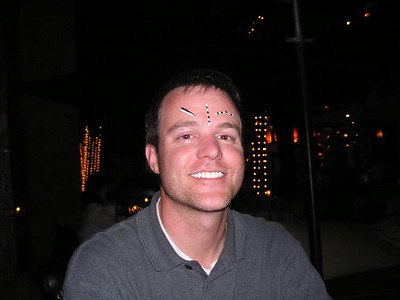
J.J.’S COMMENTS
It was a great trip – I definitely will go back and check out Cape Town next time. Also, I’ve never had a trip that lasted so many days where every meal was so good. I was surprised by the number of fences surrounding every piece of property and the number of rent-a-cops – but things generally felt safe to me.
RENTAL CAR UPDATE
Johannesburg, South Africa – Thursday/Monday
When we arrived at the Thrifty Rental Car counter in Johannesburg, the clerk informed us we were getting a “one class” upgrade. That sounded good. When we made our way to the car hire (rental car) car park (parking garage) I had a choice between a beautiful white Mercedes Compressor sedan and an SUV. Not having a trunk (SUV) to secure our valuables did not appeal to me. I chose the Mercedes.
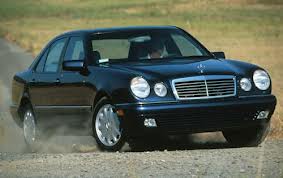
This was my first Mercedes. It was definitely a performance vehicle.
Back in 1996, I purchased a brand new Mercedes E320. That was a really nice road car. It didn’t have all of the luxury appointments that my Carol Lewis owned and Life of Virginia sponsored Lexus automobiles do but it was nice. Today’s Mercedes proved to be an excellent riding car that gave us good fuel mileage. I would recommend this car to everyone.
J.J. and I drove the Thrifty Rental Car Racing Mercedes Compressor 1,281 miles (2,051 kilometers) in the four days we had it. I paid an average price of $3.69 per gallon (7.74 South American Rand per U.S. dollar). The German-built car gave us 29.11 miles per gallon in fuel mileage at a cost of 12.7 cents (U.S.) per mile. The car cost 17.1 cents per mile to rent, all taxes included. All of these expenses were comparable to what I pay in the United States. Normally, most things I buy in foreign countries are more expensive (to me) than they are in the U.S.
Thanks for reading about my trackchasing,

Randy Lewis
KwaZulu-Natal’s #1 Trackchaser
At the speeds I drive, I don’t worry about high cholesterol
TRAVEL DETAILS
AIRPLANE
Los Angeles, CA – New York, NY – 2,430 miles
RENTAL CAR – NEW YORK, NEW YORK
John F. Kennedy International Airport – trip begins
Windsor, CT – 133 miles
Greenville Junction, ME – 543 miles
Clarence Creek, Ontario, Canada – 939 miles
John F. Kennedy International Airport – 1,413 miles – trip begins
AIRPLANE
New York, NY – Dakar, Senegal – 3,803 miles
TRANSPORTATION – DAKAR, SENEGAL, AFRICA
Used taxis exclusively
AIRPLANE
Dakar, Senegal, Africa – O.R. Tambo International Airport, Johannesburg, South Africa, – 4,192 miles
RENTAL CAR – JOHANNESBURG, SOUTH AFRICA, AFRICA
O.R. Tambo International Airport, Johannesburg, South Africa – trip begins
Durban, South Africa – 1,359 kilometers (849 miles)
O.R. Tambo International Airport, Johannesburg, South Africa – 2,051 kilometers (1,282 miles)
AIRPLANE
O.R. Tambo International Airport, Johannesburg, South Africa (with a stop in Dakar, Senegal, Africa) – Washington, DC – 8,140 miles
Washington, DC – Los Angeles, CA – 2,330 miles
Total Air miles – 20,895 miles (5 flights)
Total auto and air miles traveled on this trip – 23,590 miles
TRACK ADMISSION PRICES:
Mototown – $15
Moosehead Lake Ice Track – $10
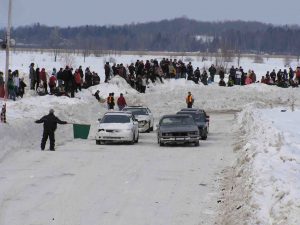
Clarence Creek Ice Track – $5 Canadian (about $5 U.S.)
Durban Grand Prix – 350 South African Rand (about $50 U.S.)
Total racetrack admissions for the trip – about $80
RANKINGS
LIFETIME TRACKCHASER STANDINGS UPDATE:
There are no trackchasers currently within 100 tracks of my lifetime total.
- Randy Lewis, San Clemente, California – 1,315
Other notables
These worldwide trackchasers are within 10 tracks (plus or minus or more) of Carol’s current trackchaser total.
- Mike Knappenberger, Reading, Pennsylvania – 449
- Carol Lewis, San Clemente, California – 356
- Ken Schrader, Concord, North Carolina – 353
- Max Allender, Des Moines, Iowa – 349
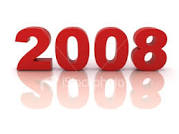
2008 TRACKCHASER STANDINGS
- Randy Lewis, San Clemente, California – 17
- Mike Knappenberger, Reading, Pennsylvania – 14
- Guy Smith, Effort, Pennsylvania – 8
- Carol Lewis, San Clemente, California – 7
- Paul Weisel, Orefield, Pennsylvania – 7
Tracks have been reported by 24 different worldwide trackchasers this season.
LIFETIME COUPLES TRACKCHASING STANDINGS
- Allan & Nancy Brown, Comstock Park, Michigan – 1,672
- Randy & Carol Lewis, San Clemente, California – 1,671
- Guy & Pam Smith, Effort, Pennsylvania – 1,664
UPCOMING TRACKCHASING PLANS
I arrived home a day later than planned. This would allow me just 48 hours or so to recuperate and be off for my next trip after being gone for 14 days. I wasn’t sure if I wanted to do that. You’ll have to be patient and wait to see if I hit the trackchasing trail so quickly after my African return or not.
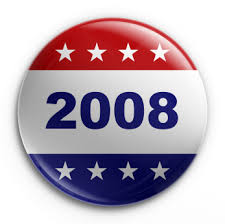
RACETRACKS VISITED IN 2008
(** not the first time to visit this track)
1,299. Barnes Lake Ice Track, Ashcroft (road course), British Columbia, Canada – January 13
1,300. Bira Circuit, Pattaya (road course), Thailand – January 19
1,301. Cameron Lake Ice Track (oval), Erskine, Minnesota – January 26
1,302. Birch Lake Ice Track (oval), Hackensack, Minnesota – January 27
1,303. Mille Lacs Lake Ice Track (road course), Garrison, Minnesota – January 27
1,304. Mille Lacs Lake Ice Track (oval), Garrison, Minnesota – January 27
1,305. Ozark Empire Fairgrounds (oval), Springfield, Missouri – February 1
1,306. Atlanta Motor Speedway (road course), Hampton, Georgia – February 2
1,307. Brainerd International Raceway Ice Track (road course), Brainerd, Minnesota – February 3
1,308. Bay of Green Bay (road course), Marinette, Wisconsin – February 9
1,309. Lake Speed Ice Track (oval), Tilleda, Wisconsin – February 9
1,310. Shawano Lake – North Shore (oval), Shawano, Wisconsin – February 10
1,311. Cecil Bay Iceway (oval) – Cecil, Wisconsin – February 10
1,312. Mototown USA (oval) – Windsor, Connecticut – February 15
1,313. Moosehead Lake Ice Track (oval) – Greenville Junction, Maine – February 16
1,314. Clarence Creek Ice Track (oval) – Clarence Creek, Ontario, Canada – February 17
1,315. Durban Grand Prix (road course), KwaZulu-Natal, South Africa – February 24
That’s all folks! Official end of the RLR – Randy Lewis Racing Trackchaser Report
It’s very rare when I use someone else’s video to show you what the racing looked like
Click on the links below
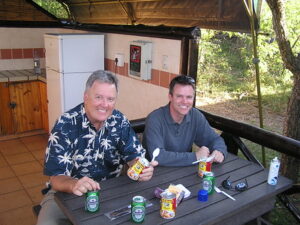
We weren’t the most prepared campers. Dinner was Vienna sausges, cheese and Heineken!
Part 1: Getting to South Africa and the safari
.
.
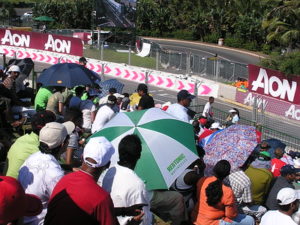
Part 2: It was time to trackchase in South Africa!

